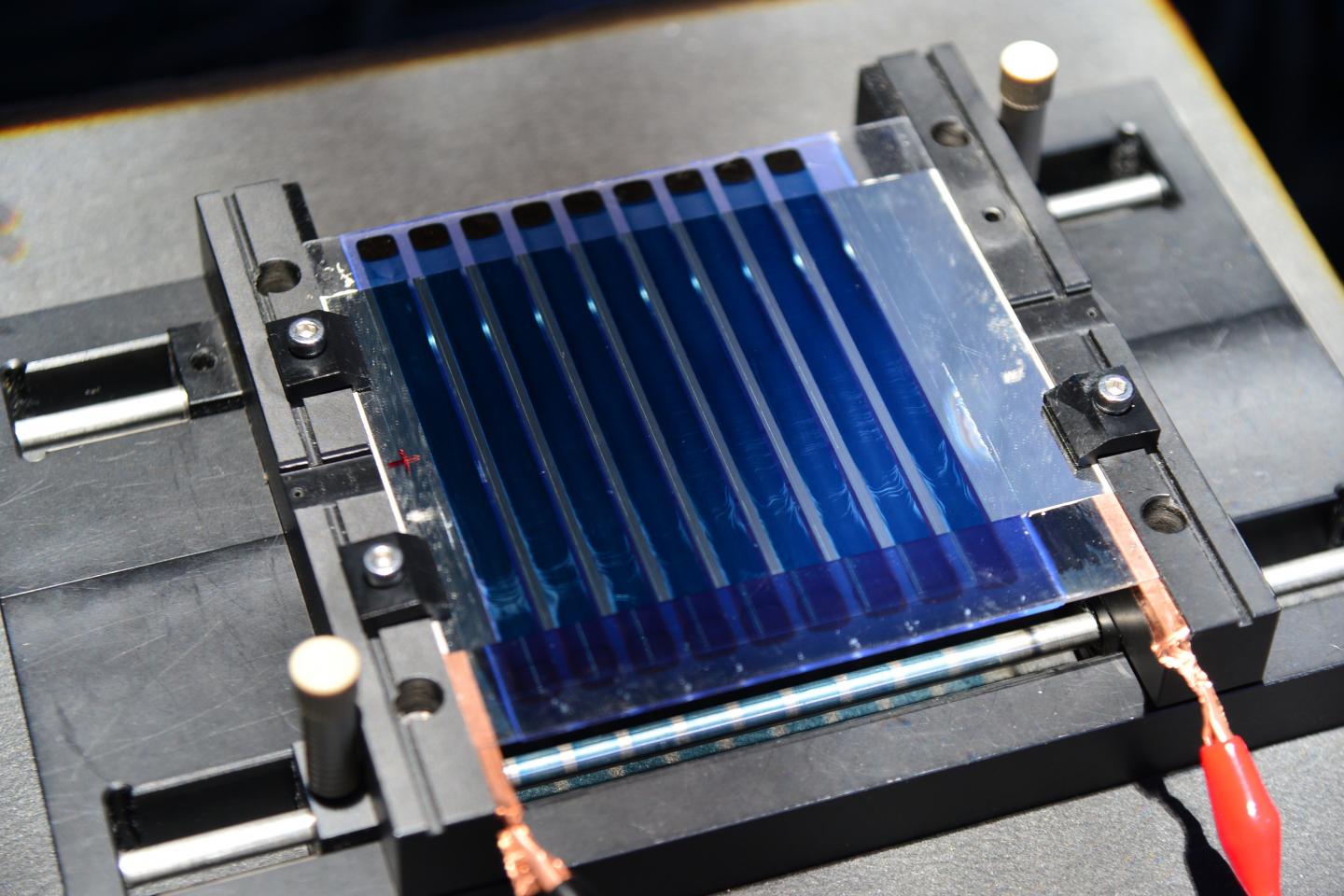
Dr. Hae Jung Son’s team at KIST implemented high-efficiency solar cell technology on a large area through solution process method that utilizes spin coating.
CREDIT: Korea Institute of Science and Technology (KIST)
Researchers identify the principles necessary for designing the core material of large-area solution processable solar cells. Future application as plastic-based photovoltaic paint technology.
Researchers in Korea have successfully developed a high-efficiency large-area organic solution processable solar cell by controlling the speed at which the solution of raw materials for solar cells became solidified after being coated. The team led by Dr. Hae Jung Son from the Photo-electronic Hybrids Research Center of the Korea Institute of Science and Technology (KIST) announced that they have identified the difference in the mechanism of film formation between a small area and a large area of organic solar cells in a solution process and, by resolving the issue concerning the related process technology, developed a high-efficiency large-area organic photovoltaics.
If a photovoltaic material is made in the form of paint that can be applied to any surface, such as the exterior of a building or a car, it will be possible to achieve energy self-sufficiency and provide low-cost eco-friendly energy to those suffering from energy poverty. Not only that, it will be easy to utilize space for installation of photovoltaics even on urban buildings, and ideally, the photovoltaic panels will be maintained by re-applying the “paint.”
When it comes to solution processable solar cells, which work by coating the surface with the solar cell solution, the photoactive area that generates electricity still remain on a laboratory scale (less than 0.1?). When applied to a large area to produce sufficient electric power for it to be practical, there are issues related reduced performance and reproducibility due to material- and process-related limitations, and this has been an obstacle to commercialization.
Dr. Son’s team at KIST revealed that commercially available organic materials become easily crystallized, which makes them unsuitable for large-area solution processes. In the case of the large-area solution process for industrial uses, the process through which the solvent in which the solar cell material is dissolved evaporates to form a film occurs slowly, thereby resulting in agglomeration and other phenomena, and this in turn lowers the efficiency of the solar cell. As for the spin coating method, which is a small-area process employed in laboratory research, the substrated is rapidly rotated during the film formation process in order to speed up the solvent evaporation, and this makes it possible to form a film without the aforementioned problem concerning reduced efficiency.
Based on this information, KIST researchers developed high-performance large-area organic photovoltaics by controlling the solvent evaporation rate following the coating step in a large-area solution process as a way to form a film optimized for solar cell performance. As a result, high-efficiency large-area organic photovoltaics with 30% higher power conversion efficiency than existing photovoltaics were attained.
Dr. Son said, “The core design principles of solar cell materials capable of high-quality large-area using the solution will accelerate the development of solution processable solar cells in the future. [This study] has contributed to not only raising the efficiency of next-generation solution processable solar cells but also the development of core technology for manufacturing large-area solar cell materials required for commercialization.”
The Latest Updates from Bing News & Google News
Go deeper with Bing News on:
Photovoltaic paint
- The Best Portable Solar Panels of 2024, Tested and Reviewed
If you’re looking to purchase both a power station and portable solar panel, check out my take on the best solar generators; It looks at which pairings provide the best bang for your buck. My portable ...
- How Much Power Does A Solar Panel Produce?
While solar panel systems start at 1 KW and produce between 750 and 850 Kilowatt hour (KwH) annually, larger homes and bigger households typically want to be on the higher end. A four-to-five ...
- Solar power in the UK - statistics & facts
Solar photovoltaic is a renewable energy technology that utilizes sunlight in order to generate electricity. A photovoltaic system is comprised of one or multiple solar panels, made up of solar ...
- Solar photovoltaic in Europe - statistics & facts
The production volume of electricity from solar photovoltaic power in the European Union (EU) has been steadily increasing in the last years. In 2021, over 157 terawatt-hours were produced ...
- American Solar Panel Manufacturers (2024)
Faith Wakefield is a writer based in North Carolina. She holds economics and English degrees from UNC Chapel Hill, and her work has been featured on EcoWatch, The World Economic Forum and Today ...
Go deeper with Google Headlines on:
Photovoltaic paint
[google_news title=”” keyword=”photovoltaic paint” num_posts=”5″ blurb_length=”0″ show_thumb=”left”]
Go deeper with Bing News on:
High-performance large-area organic photovoltaics
- Ocean protection and solar balconies: Positive environmental stories from 2024
In 2023, as part of our ongoing effort to tackle eco-anxiety (both that of our readers and our own), we kept track of all the positive environmental news throughout the year. We racked up over 200 ...
- Engineers uncover key to efficient and stable organic solar cells
A team of researchers led by Professor Philip C.Y. Chow from the Department of Mechanical Engineering at the University of Hong Kong (HKU) has made a significant breakthrough in the field of organic ...
- Architecture News
In this context, as architects and designers have moved away from symmetrical, rigid, and parallel mirror patterns, Alcon Lighting has detected a trend where linear lighting highlights asymmetrical ...
- Key to efficient and stable organic solar cells
Their research, titled "The role of interfacial donor-acceptor percolation in efficient and stable all-polymer solar cells," paves the way for more sustainable and viable solar energy solutions for ...
- A shade closer to more efficient organic photovoltaics
Transparent solar cells will transform the look of infrastructure by enabling many more surfaces to become solar panels. Now, materials called non-fullerene acceptors that can intrinsically generate ...
Go deeper with Google Headlines on:
High-performance large-area organic photovoltaics
[google_news title=”” keyword=”high-performance large-area organic photovoltaics” num_posts=”5″ blurb_length=”0″ show_thumb=”left”]










